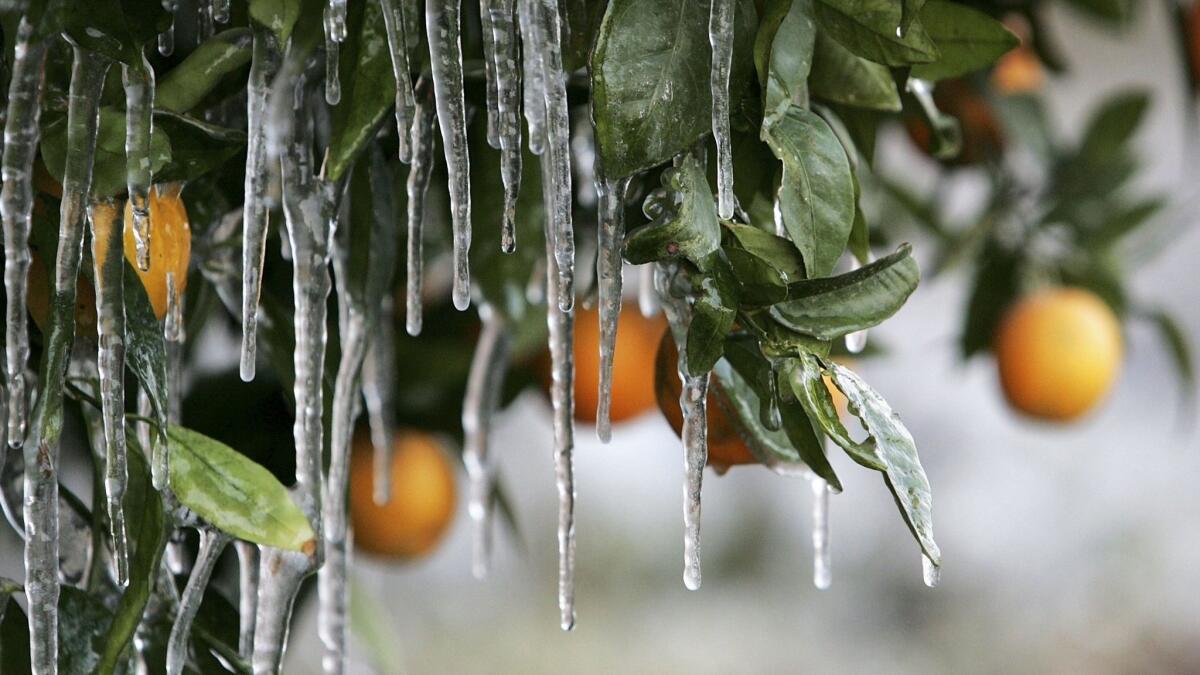5 ways to save your plants when the temperatures dip near freezing

So, yes, it’s been cold at night around Southern California, but folks, 45 degrees is a still a long way from the freezing temps that can burn our tender tropicals and other plants, like a multiday cold snap in 2007 that severely damaged crops in Central and Southern California.
Nonetheless, canyon floors and valley bottoms can see temperatures dip into the freezing range (32 degrees) even when it’s in the 40s in most other areas because cold air settles at the lowest point it can find, just like water, says Donald R. Hodel, UC Cooperative Extension landscape horticulturist for Los Angeles County.
“I was driving from the 405 to Laguna one November morning, and the temperature in the canyon was 29 degrees, but when I reached the beach it was 40 degrees,” Hodel said. “Generally Orange County doesn’t have a real problem with frost, but canyons are wind-protected, and all the cold air drains right into the canyon floor.”
Wind helps mix up the cold air with warmer air above, reducing the chance of frost, Hodel said. But on windless, clear nights, if you live at the bottom of a canyon or your backyard is mostly slope, where cold air can settle and get trapped by your house, here are a few things you can do to protect young or tender plants against damage from the cold.
1. Pay attention to the forecast
The last really bad frost in Southern California was in January 2007, Hodel said. Most weather reports will note if frost is expected, especially in wind-protected areas of the valleys. “I always look at the weather. If it’s a clear, dry day with no wind, and the high temperature stays in the 50s, there’s a good potential for frost that night. But it has to be dry,” he said, adding: “Dry air loses heat, but water holds a lot of heat, so if it rains and stays in the 50s, it will probably stay in the 40s that night, because the air is so moist.”
2. Hydrate, hydrate, hydrate
Make sure your plants aren’t water-stressed going into a cold period. Many gardeners recommend watering your plants thoroughly before a cold snap, but Hodel says the best prevention is just consistent tending of your plants in the winter. Plants need less water in the winter, and you don’t want to overwater, but if it hasn’t been raining, make sure your plants don’t dry out.
3. Take cover
If you’re worried about frost, move your potted plants under a covered patio or into the garage, anyplace they have some cover, Hodel said. On still, cloudless nights, plants radiate heat into the clear sky and can become colder than the radiant air temperature. A covered patio will help bounce that warmth back to potted plants. Use a vented cardboard box for larger plants or a gallon milk jug to protect seedlings (rinse out, cut off the bottom of the jug to fit around plans, and remove the cap so plants can breath). Or invest in frost cloth, a lightweight synthetic cloth that helps hold in a plant’s heat. Be wary of using sheets or heavier fabrics, because they can actually conduct cold to the leaves and do some damage. If your plant is too big for a frost cloth, chances are it will survive the frost without too much damage.
4. Pull out a box fan
Anyone who grew up near orange groves will remember the roar of wind machines starting in the dead of night, when the temperature got too cold. The same theory applies here, especially if you have an area where cold air can settle and be trapped by your yard or fence. A box fan will help move the cold air around, and mix it up with warming air above.
5. Leave the damage alone
Plants are heartier than we think, Hodel said. Cold-damaged plants may look bad, but postpone your pruning until March, when the danger of more frost is past. The damaged branches are actually protecting the rest of the plant from further damage, Hodel said, and they might yet revive when the weather turns warm.
More to Read
Sign up for our L.A. Times Plants newsletter
At the start of each month, get a roundup of upcoming plant-related activities and events in Southern California, along with links to tips and articles you may have missed.
You may occasionally receive promotional content from the Los Angeles Times.







